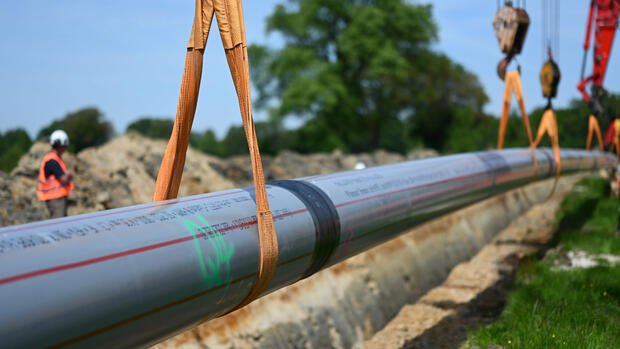From 2032, a hydrogen core network is to transport the gas through the country.
(Photo: dpa)
Berlin The operators of the long-distance gas pipelines in Germany are concretizing their plans for the construction of a hydrogen network. The Association of Gas Transmission System Operators (FNB Gas) presented its concept for a so-called “hydrogen core network” on Wednesday, which should have a length of 11,200 kilometers.
The network is intended to connect the central hydrogen sources with the main consumption points and hydrogen storage facilities. The goal is to complete the network by 2032. According to FNB Gas, more than half of the lines through which hydrogen is to flow in the future will consist of repurposed natural gas lines.
FNB Gas is the association of national gas transport companies in Germany. These include Gasunie Deutschland, Open Grid Europe (OGE), Ontras, Gascade, Thyssengas and Fluxys.
The establishment of a hydrogen network is considered a basic requirement for the ramp-up of the hydrogen economy, which the federal government is also striving for. Hydrogen can pave the way to climate neutrality wherever electricity from renewable sources is not a solution. This is the case, for example, in the steel, chemical and cement industries.
Companies have to convert processes that currently run on gas, oil or coal to hydrogen-based processes. From today’s perspective, there is no alternative to hydrogen in heavy-duty, air and shipping traffic on the way to climate neutrality.
Network is to become a “signal of departure” for the hydrogen economy
In order for hydrogen to play a key role in the climate-neutral industry of the future, it must be able to be transported over long distances. The long-distance gas pipeline operators take this knowledge into account with their plan. “A Germany-wide core network is the desired signal for all players along the value chain,” said Thomas Gößmann, CEO of FNB Gas.
>> Read also: Federal government wants to use hydrogen in all sectors
The draft has been coordinated with the Ministry of Economic Affairs and the Federal Network Agency. However, it has not yet been bindingly decided. Countries, associations and other stakeholders have until July 28 to comment. For example, you can promote the inclusion of additional lines in the hydrogen core network. The core network could then be adjusted accordingly.
Barbara Fischer, Managing Director of FNB Gas, said that they are working flat out to submit a draft for an optimized hydrogen core network to the Federal Network Agency by autumn. TSO boss Gößmann said it was “important that all market participants quickly get clarity about when and how they can contribute their needs for the further expansion stages of the hydrogen network”. This creates planning and investment security.
The question of whether and when an individual company or a specific region will be connected to a hydrogen network is of existential importance for certain sectors that can only become climate-neutral with hydrogen.
More: Who is behind Deutsche Regas?

